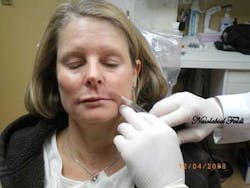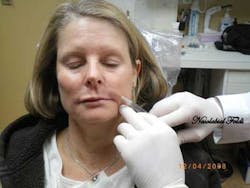Five ways to launch a successful safety management program: infection control and safety considerations
By Olivia Wann, RDA, BSAs dental professionals, our training and education prepare us for patient care. Once hired into our job assignments — whether we are dentists, hygienists, assistants, or administrative staff — we soon realize how to multitask and juggle patient care, administrative duties, and oh yes, safety management. Whether handled by an experienced safety coordinator, a newly appointed OSHA compliance coordinator, or the efficient team member who willingly takes on more responsibilities, we strive for success in our safety management programs. Safety should never be compromised to a busy schedule or lack of information.“So who’s in charge of OSHA around here?” may be a familiar question. What may also be familiar is the unnerving, “I’ve been stuck with a dirty needle! What do I do now?” Perhaps a dusty pile of material safety data sheets awaits someone’s attention. Safety policies are either nonexistent or need updating. Weekly spore testing documentation may not be available. A frustrating “We don’t do it that way” may be a common response. To launch a successful safety management program, someone must take the lead in training staff and developing policies. Is that safety person you? Welcome to the world of safety. Rather than feeling defeated by a huge, serious assignment, approach safety management systematically. 1. Carefully review OSHA’s Bloodborne Pathogens Standard and the latest CDC infection-control guidelines for dental office settings. Remember, faulty systems lead people to make mistakes. Not having a program or limping on a weak, outdated system can result in errors, citations, and compromised safety. For example, in one busy office, a batch of nonsterile instruments was erroneously released for distribution. Despite the ultrasonic cycle and sterilization, surgical forceps remained caked with blood.
Surgical forceps caked with bloodWe live in a culture of blame, particularly in health care. The mediolegal environment and its tort process reinforce the assignment or shifting of blame.1 If you take the lead in safety management, you realize how important it is to gain the cooperation of your team members. Blaming previous employees or pointing fingers at weak employee performance does not strengthen the process. Keep in mind that if we depend on a team member, we are often disappointed. Create a system and depend on the system. Regardless of any practice hiccups, such as a new hire, an employee on maternity leave, an employee who calls in sick, or any number of things that modify our workday, our system must remain intact. 2. Assess what documentation must be put into place. Educate yourself on how to put the program together, or outsource the project to a reputable compliance group. Note OSHA’s requirements: “Employers shall ensure that all employees with occupational exposure participate in a training program, which must be provided at no cost to the employee and during working hours.” 29 CFR 1910.1030(g)(2)(i). The frequency is noted as, “At least annually thereafter.” 29 CFR 1910.1030(g)(2)(ii)(C). Include an evaluation of a safer medical device. Ensure the development of a work exposure control plan that includes a protocol for exposure incidents.2 Therefore, the “system” is to prevent needlesticks and sharps injuries.CDC estimates that health-care workers sustain 385,000 needlesticks and other related sharps injuries in hospital-based settings annually, amounting to 1,000 sharps injuries daily. Unfortunately, no data is available for dental office settings, specifically due to a lack of surveillance systems.3The most common infections occupationally transmitted via sharps injuries during patient care include hepatitis B, hepatitis C, and HIV. CDC also notes that the risk includes herpes, malaria, and M. tuberculosis.4Costs associated with post-exposure management of health-care personnel range from $500 to $3,000.5 CDC revealed that if the worker is infected, the cost to treat the individual’s bloodborne illness over a lifetime is estimated at $1.0 million. This data has captured the attention of lawmakers and safety groups. 3. Assess your dental office. How can we make the workplace safer and comply with the latest infection-control guidelines?This article is simply an overview of the many facets of job safety and infection control. For the purpose of this discussion, we’ll start with the sterilization area. In compliance with OSHA’s Hazard Communication standard, affix chemical identification labels to secondary containers such as the ultrasonic unit, high-level disinfectants, plaster and stone bins, COE cleaner container, alcohol containers, spray bottles, and more. Assure the “dirty” to “clean” flow of your central sterilization area.6 This common violation requires simple changes. Wear heavy-duty utility gloves when handling loose contaminated instruments. Use an automatic process for pre-cleaning the instruments, such as an ultrasonic unit or a dental instrument washer.
Dental instrument washerIf instruments cannot be pre-cleaned immediately, soak in an enzymatic cleaner or use an enzymatic spray pre-cleaner to prevent drying of debris, which can make auto-cleaning ineffective. Test the ultrasonic unit or dental instrument washer routinely to assure maximum performance. Log your results in your quality control records. Loose instruments should be placed in appropriate containers at the point of use to prevent sharps injuries during transport to the sterilization area.7 If you are currently not using the instrument cassette system, consider its advantages: the cassettes allow procedural sets of instruments to remain intact throughout use, transportation, cleaning, sterilization, and storage.8
Hu-Friedy instrument cassettePony tail holders are not recommended to maintain a procedural set due to the cleaning agent’s inability to effectively clean between instruments, as well as the increased potential for sharps exposure.When using the cassette system, the instruments are returned to the cassette and locked into place, thus reducing the risk of a potential injury. As pictured, the cassette is wrapped to maintain sterility during storage.
Wrapped cassetteSecure the packaged cassette with autoclave tape.9 Place other instruments and items in autoclave pouches. Date the packages and ensure effectiveness of the sterilization process with mechanical, chemical, and biological monitors. Note: “Critical and semi-critical instruments that will be stored should be wrapped or placed in containers, such as cassettes or organizing trays, designed to maintain sterility during storage.”10 Gone are the days of opening mobile cart or cabinet drawers and seeing loose instruments.4. Use devices intended for heat sterilization that are cleared by the FDA. Pressure cookers and toaster ovens are not FDA-cleared as medical devices. Never overload the sterilizer’s chamber. Follow the manufacturer’s instruments for sterilization. Remember — allow the instrument packs to dry inside the chamber before moving and handling the packs or cassettes to prevent transmission of bacteria from your hands to the packaging material. Damp packages are not considered sterile, thus inspect the packs prior to storage. Store the cool and dry instrument packages and cassettes in closed or covered drawers or cabinets. Maintain the sterilizer according to the manufacturer’s operating instructions, including routine replacement of the gaskets and using recommended cleaners. Include the maintenance performed in your quality control records. Most states require a minimum of weekly biological monitoring for quality assurance. Most sterilization failure is traced to human error such as overloading, inadequate space between instrument packs, and improper or excessive packaging.11 Maintain an orderly logbook for easy reference or site audits.5. Look carefully at the treatment rooms. Is a sharps container available? Are surface barriers used for hard-to-clean surfaces? Are items stored in the cabinets and drawers to avoid cross-contamination? What kind of surface disinfectant is in use?Surface disinfection seems simple, and yet this area begs our attention. First, determine the type of product in use and compare how it is currently being used with the manufacturer’s instructions. Deviation is frustrating and can result in compromising safety. This is often the result of not reading product labels or not staying current on infection-control training. As we learned in school, we must first “clean” the surface prior to applying disinfectant. Many offices use pre-moistened wipes. Using wipes does not mean merely pulling out one wipe and miraculously disinfecting the entire operatory with one quick swoop. Ascertain that the wipe may be used as a cleaner. If so, use the first wipe to clean the surface and remove debris and bioburden. Discard this wipe. Next, dispense a second wipe to disinfect the pre-cleaned surface. Follow the label instructions for appropriate contact times. Discard wipe. Some wipes cover a limited surface area, such as three square feet. Simply evaluating the practice’s documentation, training needs, set up and flow of the sterilization area, instrument management, and disinfection of the treatment room reminds us how important our jobs are in promoting job safety among our fellow team members, as well as safe dental treatment for our patients. The provision of dental care does not stop when the patient is dismissed — intensive effort is invested to properly decontaminate the treatment room and process the instruments. Nothing is left to chance. In summary, learning about safety management and infection control is critical for dental health professionals. Taking the lead in this assignment, drafting the necessary policies and procedures, and providing training for our staff will help dental offices comply with the regulations and established guidelines. Author bioOlivia Wann, RDA, BS, is the owner of Modern Practice Solutions, LLC. She has provided more than 250 national seminars on compliance topics. She is currently a 2011 candidate for a Doctorate in Jurisprudence at the Nashville School of Law in Nashville, Tenn. She is a member of Organization for Safety, Asepsis and Prevention, American Association of Dental Office Managers, and the American Association of Health Lawyers. Olivia’s company provides in-office consultations and seminars. Contact her at [email protected]. References1. Holden, Richard J., “People or Systems?” Professional Safety, Journal of the American Society of Safety Engineers, Dec. 2009; 35.2. OSHA, Bloodborne Pathogens Standard, 1910.1030(c)(1)(i), and 1910.1030(f)(3).3. CDC, “Sharps Injury Prevention Workbook,” available at www.cdc.gov/Sharpssafety/pdf/WorkbookComplete.pdf, p. 7.4. CDC, “Sharps Injury Prevention Workbook,” available at www.cdc.gov/Sharpssafety/pdf/WorkbookComplete.pdf, p. 4.5. CDC, “Sharps Injury Prevention Workbook,” available at www.cdc.gov/Sharpssafety/pdf/WorkbookComplete.pdf, p. 9.6. CDC, Vol. 52 / RR-17,Guidelines for Infection Control in Dental Health-Care Settings,” 2003; p. 21.7. CDC, Vol. 52 / RR-17,Guidelines for Infection Control in Dental Health-Care Settings,” 2003; p. 21.8. Cuny E, Collins FM. “Instrument Processing Work Flow and Sterility Assurance,” PennWell, 2010; p.3.9. OSAP, “From Policy to Practice,” p. 49.10. CDC, Vol. 52 / RR-17,Guidelines for Infection Control in Dental Health-Care Settings,” 2003, p. 23.11. OSAP, “From Policy to Practice,” p.58.





